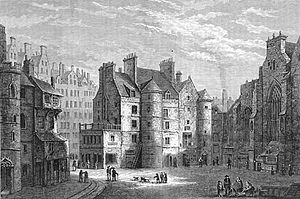Old Tolbooth, Edinburgh
| Old Tolbooth, Edinburgh | |
|---|---|
 |
|
| Former names | Pretorium Burgi |
| General information | |
| Type | Municipal building |
| Architectural style | Scottish Medieval |
| Location | High Street |
| Town or city | Edinburgh |
| Country | Scotland |
| Coordinates | 55°56′57.95″N 3°11′30.21″W / 55.9494306°N 3.1917250°W |
| Construction started | 1386 |
| Completed | c. 1400 |
| Renovated | 1561 |
| Demolished | 1817 |
The Old Tolbooth was an important municipal building in the city of Edinburgh, Scotland for more than 400 years. The medieval structure, which was located at the northwest corner of St Giles' Cathedral and was attached to the west end of the Luckenbooths on the High Street in the Old Town, was first established in the 14th century by royal charter. Over the years it served a variety of purposes such as housing the Burgh Council, early meetings of the Parliament of Scotland and the Court of Session. The Tolbooth was also the burgh's main jail where, in addition to incarceration, physical punishment and torture were routinely conducted. From 1785 public executions were carried out. In 1817 the buildings, which had been rebuilt and renovated several times, were demolished.
A deed in the chartulary of St Giles' Cathedral indicates there was already a pretorium (an earlier Latin term for a tolbooth) in Edinburgh as early as 1368. Following the burnings of Edinburgh by Edward II of England in 1323 and his son, Edward III, in 1335 during the Wars of Scottish Independence and again in 1385 when Richard II of England burned the town, major rebuilding and improvements were required. In 1386, Robert II granted Edinburgh a charter which gave the burgh an area of land 60 feet (18 m) by 30 feet (9.1 m) in the market place with licence to develop the site for the ornament and use of the city. The charter, written in Latin, was endorsed "Carta fundi de la Belhous" (English: Charter of the site of the Belhous), signifying the purpose of the site for a new Belhouse, successor to the earlier pretorium, and may be translated:
...
Wikipedia
